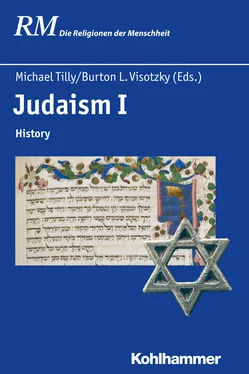1 ...6 7 8 10 11 12 ...34 Skilled persons have been translating the Bible for more than two millennia. Except for the LXX translation, some version of the MT has been the basis of virtually every translation of the Hebrew Bible. Of the ancient translations, the Aramaic Targumim reflect the views of the rabbis.
14 Jewish Literature in the Hellenistic-Roman Period (350 B.C.E. –150 C.E.)
Dr. Michael Tilly of Eberhard Karls University of Tübingen surveys Jewish literature from the close of the Hebrew Bible up to rabbinic literature. Koine Greek was the lingua franca throughout the eastern Mediterranean. Jewish writings from Hellenistic-Roman times comprise different genres, styles, and linguistic levels. These texts were composed primarily in the three centers of ancient Judaism: the Land of Israel, Egypt, and Babylonia (Iraq). The rabbis did not hand down Hellenistic-Jewish literature. Rather, Greek Jewish literature was handed down, translated, revised, and supplemented exclusively by Christianity.
Historical and legendary texts are considered, such as: 3 Ezra, 1–3 Maccabees, Judith, Greek Esther, the Greek Daniel traditions: Susanna; Bel and the Dragon; Prayer of Azariah; the three men in the fiery furnace. Dr. Tilly also surveys: the Paraleipomena Jeremiou and Vitae Prophetarum, Hellenistic-Jewish historians, whose work is often fragmentary including Eupolemus, Artapanos, and the works in Hecataeus of Abdera.
Dr. Tilly turns next to teachings in narrative form such as: Tobit, the Letter of Aristeas, which recounts the legend of the commission and translation of the LXX, the Book of Jubilees, Ascensio Isaiae, as well as a Life of Adam and Eve (in Latin) or Apocalypse of Moses (Greek). The Liber Antiquitatum Biblicarum was falsely attributed to Philo in the Middle Ages. The Hellenistic novel Joseph and Asenath is also reviewed.
Other works such as the Teachings of Ben Sirach, the Wisdom of Solomon, Book of Baruch, Epistle of Jeremiah, 4 Maccabees, the Testament of the Twelve Patriarchs, and the Testament of Job are included. The thoroughness of the survey is indicated by Dr. Tilly’s inclusion of the Hellenistic-Jewish exegetes Demetrios, Aristobulus, and another exegete called Aristeas (not the one already mentioned).
A section follows on poetry: Psalm 151, the Psalms of Solomon, Pseudo-Phocylides, and Ezekiel the Tragedian’s Exagogé . The chapter continues with Greek Apocalyptic works such as the Greek and the Syriac Apocalypses of Baruch, the Ascension of Moses, 4 Ezra, the Apocalypse of Abraham, 1–2 Enoch, and the Sibylline Oracles. Dr. Tilly briefly surveys the various non-biblical Dead Sea Scrolls, before concluding with the works of Philo and Josephus.
Professor Emeritus at the University of Vienna, Günter Stemberger writes that the first generations of the rabbis, from 70 CE to the early third century, are called tannaim (plural), derived from Aramaic tanna , ›to repeat, learn.‹ Traditionally, these masters begin with Hillel and Shammai in the first century CE, and their ›houses‹ or schools. They were followed by masters of Yavneh after 70 CE: Yoḥanan ben Zakkai, Rabban Gamaliel, Rabbis Yishmael and Aqiva. The Tannaim continued through the rabbis of Usha, after the Bar Kokhbah-revolt (132–135): Simeon ben Gamaliel, and R. Meir, culminating with Yehudah ha-Nasi, called Rabbi (ca. 200 CE).
Rabbi edited the Mishnah, the most important literary product of the rabbis. It consists of six ›orders‹ ( seder , plural: sedarim ), each divided into tractates. The work used pre-existing sources and traditions and was ›published‹ in oral form. Some of mishnaic halakhah is from the Bible, but the relationship of the Mishnah to Scripture does not imply a direct line of development from biblical times. Many tractates of the Mishnah depict rituals of the Temple. R. Yehudah and his co-workers reformulated the traditions they received. Repetitions and contradictions within the book and the inclusion of opinions with which Rabbi does not agree, led scholars to consider the Mishnah as a collection or a teaching manual.
The Tosefta (Aramaic) means ›supplement.‹ It denotes additional teachings supplementing the Mishnah, having the same six orders and tractates. The Tannaitic halakhic midrashim are on Exodus through Deuteronomy, interpreting their biblical texts verse by verse and often word by word. Their main interest is halakhah, which they derive from Scripture instead of independently, as do the Mishnah and Tosefta. They do not bypass the narrative parts of biblical sections and therefore are also haggadic.
Baraita de-melekhet ha-mishkan, a work in Mishnaic Hebrew quoting Tannaitic masters, describes in the construction of the tabernacle, the dimensions and history of the ark, the placement of the tablets and Torah scrolls, the showbread table, and other items of the sanctuary. The last work to be considered is Seder ʿOlam , a midrash whose main interest is chronographic.
16 Amoraic Literature (ca 250–650 CE): Talmud and Midrash
Dr. Carol Bakhos of UCLA surveys the period of the Amoraim (»expositors of tannaitic tradition,« »those who say«). These rabbis lived in Palestine (The Land of Israel) and Babylonia (Iraq), and their teachings serve as the basis of both the Palestinian Talmud (also known as the Talmud Yerushalmi or the Jerusalem Talmud), and the Babylonian Talmud (or Bavli). The explanation, qualification, and amplification of the Mishnah is at the heart of the Talmuds. The Palestinian Talmud is a shorter work redacted about two to three centuries before the Bavli. It came together within a Byzantine Roman milieu that included pagans and Christians. The Bavli developed within a Sasanid context, primarily among Zoroastrians. Scholars today pay a great deal of attention to the ambient religions and cultures, as well as social and political forces, to explain halakhic discrepancies between the two Talmuds.
There are five generations of Palestinian Amoraim and six generations of Babylonian Amoraim. Travel between the two centers of learning took place. In both Palestine and Babylonia, rabbinic schools were small and loosely structured groups of students who studied with individual sages. Disciples were free to move from one teacher to another. By the sixth century, these master-disciple circles gave way to more organized rabbinic academies. The Talmuds recount didactic stories about the lives of amoraim and convey snippets of biographical detail. The Babylonian Talmud paints a picture of their insular world and what was required of them to pursue the study of Torah.
The rabbis produced works of biblical exegesis: Midrash, (Hebrew root drš , »to investigate, seek out«) which is a process of scriptural interpretation. The Amoraim also produced several compilations of aggadic scriptural interpretation: Genesis Rabbah , Leviticus Rabbah , Pesikta de Rav Kahana (organized around the synagogue Torah-reading cycle), and Lamentations Rabbah . These rabbis are also mentioned in later collections of midrash, such as Song of Songs Rabbah . The aggadic midrashim of the amoraic period deal primarily with the narrative portions of the Hebrew Bible.
17 Rabbinic-Gaonic and Karaite Literatures (ca. 650–1050 CE)
Rare is the scholar who can write with expertise about the literature of both the rabbis and the Karaites. Dr. Ilana Sasson was such a scholar, but she left us at a tragically young age. Dr. Burton Visotzky, of New York’s Jewish Theological Seminary and Dr. Marzena Zawanowska of the Institute of History, University of Warsaw, and Jewish Historical Institute, join together to offer this two-part chapter, dedicated to Ilana’s blessed memory.
Читать дальше







